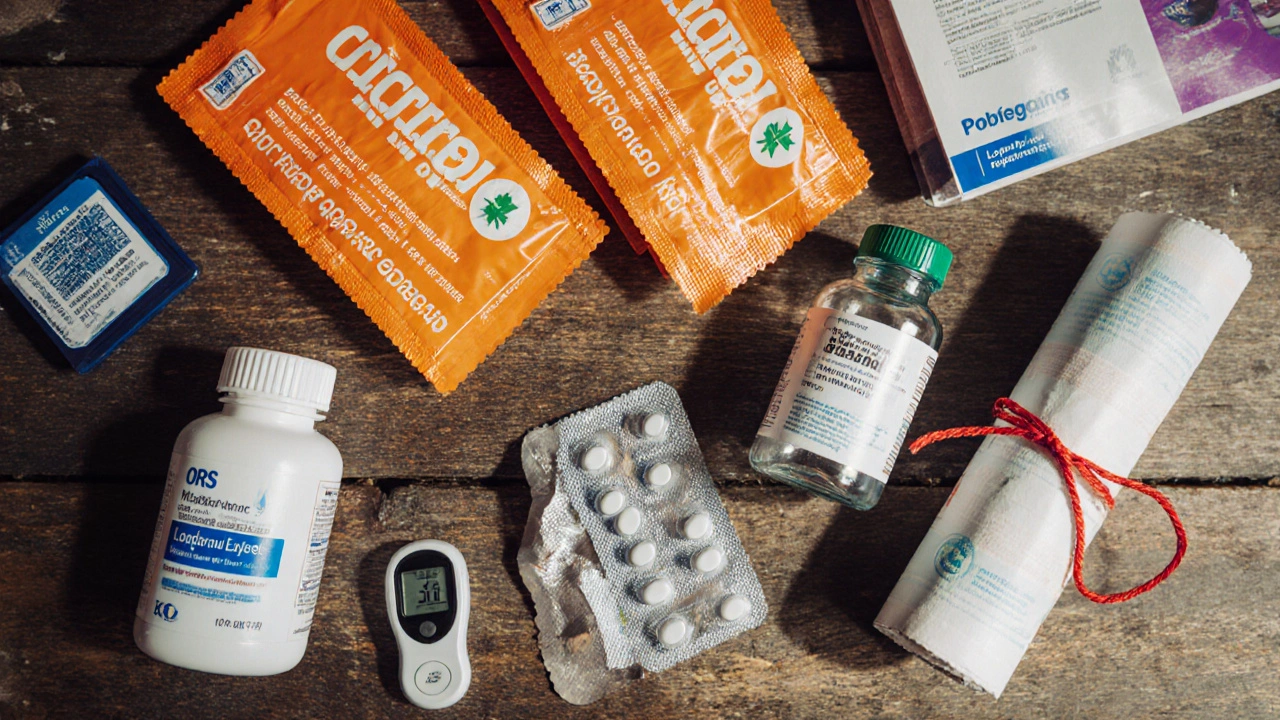Traveler's Diarrhea Medication Calculator
Medication Calculator
Your Recommendations
ORS Packets
Antibiotics
Loperamide
Special Considerations
Recommended Packing Checklist
- ORS packets
- Antibiotics
- Loperamide tablets
- Water purification tablets
- Thermometer
- Prescription copy
Getting sick on the road is a nightmare, especially when traveler's diarrhea hits you in the middle of a packed itinerary. It’s the most common ailment affecting people who cross borders, but with the right know‑how you can keep it at bay and bounce back fast.
What Is Traveler’s Diarrhea?
Traveler’s Diarrhea is a short‑term intestinal infection that usually causes three or more loose stools in a 24‑hour period, often accompanied by cramping, nausea, or low‑grade fever. It typically lasts from a few days to a week and is most frequently triggered by consuming contaminated food or water while traveling.
Common Causes and Their Risks
The culprits are mostly bacteria, but parasites and viruses also play a role. Below is a quick snapshot of the three leading pathogens.
| Pathogen | Type | Typical Incubation | First‑line Treatment |
|---|---|---|---|
| Escherichia coli (ETEC) Enterotoxigenic strain that releases toxins in the gut | Bacteria | 6‑48hours | Oral rehydration + antibiotics if severe |
| Salmonella Food‑borne bacterium often linked to undercooked poultry | Bacteria | 12‑72hours | Supportive care; antibiotics for high‑risk patients |
| Giardia lamblia Protozoan parasite found in contaminated water | Parasite | 1‑2weeks | Metronidazole or tinidazole |

How to Prevent It Before You Go
- Schedule a pre‑travel health check. CDC U.S. Centers for Disease Control and Prevention offers country‑specific risk tables you can download.
- Get recommended vaccinations. For some regions, the WHO World Health Organization advises typhoid or cholera shots.
- Pack a travel health kit (see the checklist later). Having the right meds on hand cuts down on panic.
- Study local food customs. Knowing which dishes are traditionally served raw helps you steer clear.
Smart Food and Water Choices On the Road
- Drink only sealed bottled water or treat tap water with a reliable purification method (e.g., chlorine tablets, UV pens).
- Avoid ice cubes unless you’re sure they’re made from safe water.
- Eat foods that are cooked hot and served immediately. The “hot‑up‑fast” rule works well in street‑food markets.
- Peel fruits yourself, or choose ones you can wash with safe water (bananas, oranges).
- Consider probiotic‑rich foods like yogurt, but check that they’re kept refrigerated.
- Use Probiotics Live microorganisms that may support gut balance as a daily supplement; studies show modest reduction in diarrhea incidence for travelers.
If You Get Sick: Immediate Steps and Treatment
First, assess severity. Most cases are mild and resolve with hydration alone. Follow these steps:
- Start Oral Rehydration Solution (ORS) A precise mix of salts and glucose that replaces lost fluids every hour. Commercial packets are cheap and widely available.
- Take over‑the‑counter anti‑spasmodics (e.g., loperamide) only if you have no fever or blood in stool.
- If you have a fever above 38.5°C, bloody stools, or dehydration signs (dry mouth, dizziness), seek medical care immediately.
- For bacterial infections suspected to be severe, a short course of Ciprofloxacin Fluoroquinolone antibiotic commonly prescribed for traveler’s diarrhea or azithromycin is effective. Verify local resistance patterns first.
- After recovery, gently re‑introduce bland foods (BRAT diet) and avoid heavy spices for 24‑48hours.

Packing Checklist: Meds and Supplies
- ORS packets (at least 6‑12)
- Antibiotic kit (e.g., ciprofloxacin 500mg tablets, 5‑7 doses)
- Loperamide tablets (2mg, 4‑6 tablets)
- Probiotic capsules (minimum 10billion CFU, 14‑day supply)
- Water purification tablets or a portable UV purifier
- Thermometer and basic first‑aid items (band‑aids, antiseptic wipes)
- Prescription copy and a brief note of your medical history (useful if you need a local doctor).
Special Considerations for Different Destinations
South‑East Asia: High humidity fuels bacterial growth. Stick to boiled water and avoid salads from street stalls.
Latin America: Rural areas may have Giardia. Carry metronidazole if you’re venturing off the beaten path.
Middle East & North Africa: Tap water can be heavily chlorinated, which may still upset sensitive stomachs. Bottled water is safest.
High‑altitude regions (e.g., Andes, Himalayas): Dehydration happens faster, so increase ORS intake and monitor urine color.
Frequently Asked Questions
Can I take antibiotics without a prescription while traveling?
In many countries you can buy a short‑course antibiotic over the counter, but it’s safer to bring a prescription from home. This ensures you get the right drug and dosage, and reduces the risk of using an ineffective antibiotic due to local resistance.
How many ORS packets should I pack for a two‑week trip?
Plan for at least one packet per day of potential illness, plus a few extras. For a 14‑day journey, 20‑24 packets give a comfortable safety margin.
Is drinking coffee risky for preventing diarrhea?
Coffee itself isn’t a major risk, but many cafés use tap water for brewing. If you’re unsure about water quality, stick to bottled or filtered coffee.
Should I use probiotics before I leave or only after I get sick?
Start them a few days before departure and continue throughout the trip. Maintaining a healthy gut flora can lower the chance of an upset stomach when you encounter new microbes.
What are the signs that dehydration is becoming dangerous?
Look for dark yellow urine, dizziness, rapid heartbeat, dry mouth, and inability to sweat. If any appear, increase ORS intake and seek medical help promptly.






George Frengos
Great rundown! The checklist alone is a solid starter for anyone heading into high‑risk zones. Packing ORS packets and probiotics ahead of time saves a nasty surprise later on. I always make sure my water purification tablets are within easy reach in my daypack, and I double‑check that the bottle caps are sealed before I leave the hotel. Staying on top of the “hot‑up‑fast” rule for street food really cuts down on the odds of getting sick. If you combine these basics with a quick visit to a travel clinic for a personalized prescription, you’re practically bullet‑proof.
Jonathan S
It is utterly irresponsible to wander into foreign lands without a solid plan for gastro‑intestinal safety; the very notion of neglecting the simple steps outlined above smacks of complacency that many seasoned travelers have learned the hard way. One cannot simply rely on luck when the consequences include missed flights, ruined itineraries, and, worst of all, suffering the indignity of a diarrheal episode in the middle of a bustling market. 📛 The guide does a commendable job of highlighting the essentials, yet I would go further and demand that every traveler carry a sealed, pre‑measured dose of antibiotics prescribed by a licensed physician, regardless of their perceived “low‑risk” destination. 🚫 Ignoring the subtle warnings embedded in local water quality reports is akin to walking blindfolded into a traffic jam; the stakes are far too high for such negligence. 📢
Charles Markley
From an epistemological standpoint, the heuristic framework presented herein suffers from a paucity of granularity concerning microbial resistance patterns endemic to specific micro‑biomes. The prescriptive reliance on ciprofloxacin as a panacea betrays a reductive understanding of pharmacodynamic variability across geographies. One must invoke a nuanced, evidence‑based stratification schema that integrates antibiogram data with host immunocompetence metrics before endorsing a monolithic antibiotic regimen. Moreover, the omission of adjunctive anti‑inflammatory agents constitutes a glaring lacuna in the therapeutic algorithm.
Amy Morris
Reading this guide feels like a warm hug before a long trek; the way it breaks down each step makes the fear of falling ill melt away. I’ve seen fellow travelers crumble after a bout of diarrhea, and the simple act of having ORS in your bag can be the difference between a ruined vacation and a quick recovery. The checklist reads like a lifesaver rope, pulling you back up when you’re about to slip.
Francesca Roberts
Yeah, because nothing says “I'm prepared” like stuffing a handful of packets into a side‑pocket and hoping you remember how to mix them when nature calls. 🙄 Just slap a few pills in your luggage and call it a day; the world’s a safe place, right?
Becky Jarboe
The distinction between “high‑risk” and “low‑risk” regions could use a bit more context; for example, urban centers in Southeast Asia often have better water treatment than rural villages, yet they’re both lumped together. Understanding that nuance helps travelers allocate resources more efficiently.
Tyler Dean
Don't forget that many “official” antibiotics are manufactured overseas with questionable quality controls, so relying on them can be a gamble.
Susan Rose
When I was in Thailand, the street vendors actually offered boiled water on the side-just ask for “น้ำเดือด” and they’ll oblige. It’s a simple tip that trips many travelers miss.
diego suarez
Travel health is a shared responsibility; packing the right supplies shows consideration for both yourself and the locals you interact with.
Manno Colburn
Honestly, I think you’re underestimating the psychological impact of a sudden gastrointestinal crisis on a traveler’s morale. Imagine being stuck in a remote host‑family home, unable to partake in the communal meals that were promised to be “authentic experiences,” all while your stomach is staging a rebellion. That kind of humiliation can ripple into your entire trip, turning what should have been a cultural immersion into a solitary battle against your own body. So when we talk about “responsibility,” we should also acknowledge the emotional toll and not just the logistical checklist.
Namrata Thakur
One of the most effective ways to prevent traveler’s diarrhea is to understand the epidemiology of the regions you plan to visit, because different continents harbor distinct dominant pathogens. In South‑East Asia, for instance, enterotoxigenic Escherichia coli (ETEC) is the leading cause, whereas in parts of Latin America you’ll also encounter Giardia lamblia, especially in rural water sources. By tailoring your prophylactic regimen to these risks-such as carrying a course of ciprofloxacin for bacterial threats and metronidazole for possible protozoal infections-you dramatically reduce the chance of a severe episode. Equally important is the routine use of oral rehydration solution (ORS) at the first sign of loose stools, because dehydration can set in faster than most travelers anticipate, particularly at high altitude where fluid loss is accelerated. The guide’s recommendation of at least six ORS packets per two‑week trip is a solid baseline, but I would advise packing a few extra packets for unexpected over‑use. Probiotics, while not a substitute for medical treatment, have been shown in multiple trials to lower the incidence of traveler’s diarrhea by roughly 20 percent when taken consistently before and during travel. Choose a strain with Lactobacillus rhamnosus GG or Saccharomyces boulardii for the best evidence‑based results. When it comes to food, the “hot‑up‑fast” rule remains paramount: only consume foods that have been cooked to a rolling boil and served immediately, and avoid any salad or raw vegetables unless you can peel them yourself with safe water. Ice cubes are another hidden hazard; only accept them if you are certain they were made from bottled or purified water. For water, a combination of filtration and chemical disinfection-such as chlorine dioxide tablets-provides a double layer of protection. If you’re traveling to areas with known antimicrobial resistance, consult the latest CDC or WHO reports to adjust your antibiotic choice accordingly, as fluoroquinolone resistance is rising in several Asian countries. In the event that you do develop symptoms, start ORS right away, consider a dose of loperamide only if you have no fever, and if the illness persists beyond 48 hours or worsens, seek medical care promptly. Remember to bring a copy of your prescription and a brief medical history note, as local providers may need that information to prescribe the correct medication. Finally, after recovery, re‑introduce foods gradually-starting with the BRAT diet-and give your gut time to heal before returning to a full, spicy menu. Following these comprehensive steps will not only safeguard your health but also allow you to enjoy the cultural experiences without the dread of an untimely bathroom emergency.
Chloe Ingham
Traveling is the best education.
Mildred Farfán
Honestly, the only thing more terrifying than a bacterial outbreak abroad is trying to explain to customs why you’re lugging around a half‑dozen ORS packets.
Danielle Flemming
Love the vibe of this guide! I’m already adding extra probiotic gummies to my packing list, and I can’t wait to explore the street markets with confidence.
Anna Österlund
Stop overthinking it-just follow the checklist, stay hydrated, and you’ll crush any gut trouble that dares show up.